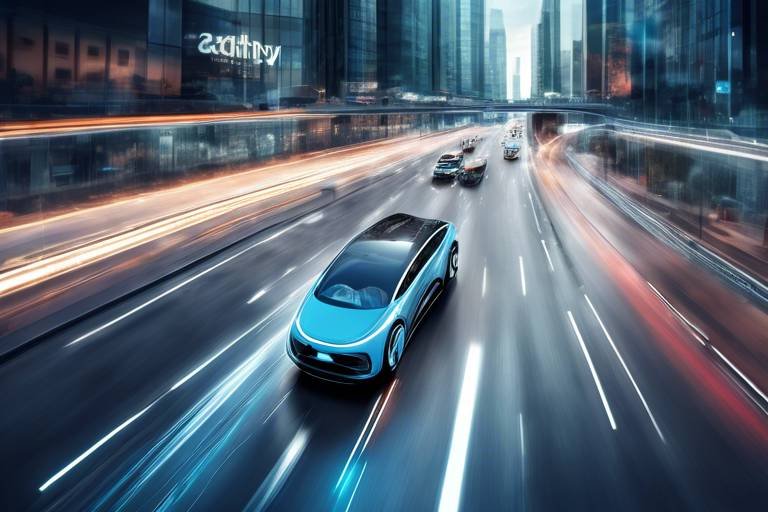AI Innovation in Vehicle Connectivity: Future Trends
In recent years, the automotive industry has witnessed a remarkable transformation driven by artificial intelligence (AI). This revolutionary technology is not just a buzzword; it’s reshaping how vehicles connect with each other and their surroundings. Imagine a world where your car can communicate with traffic lights, other vehicles, and even pedestrians, all to ensure a safer and more efficient driving experience. This article dives deep into how AI is paving the way for the future of vehicle connectivity, exploring emerging trends, potential challenges, and the profound impact on both the automotive industry and consumer experiences.
AI is at the forefront of this transformation, enabling vehicles to engage in smarter communication with infrastructure and other vehicles. It enhances safety by providing real-time data analysis and decision-making capabilities. Think of AI as the brain of your vehicle, processing information at lightning speed to make split-second decisions that could save lives. For instance, when a car detects an obstacle, AI can quickly analyze the situation and determine the best course of action, whether that’s applying the brakes or steering away. This level of connectivity not only improves safety but also enhances the overall user experience, making driving not just a necessity but a pleasure.
As we look ahead, several innovative technologies are reshaping the landscape of automotive connectivity. Technologies like 5G, Vehicle-to-Everything (V2X) communication, and edge computing are becoming game-changers, providing faster data transmission and enhancing interactions between vehicles and their environment. These advancements are akin to upgrading from a dial-up connection to high-speed internet; the difference is monumental. The ability to transmit data at unprecedented speeds allows for a seamless flow of information, which is essential for the development of autonomous vehicles and smart cities.
The rollout of 5G technology marks a significant leap forward in vehicle connectivity. With its high-speed internet access and low latency, 5G is crucial for real-time applications, particularly in the realms of autonomous driving and smart city integration. Imagine a scenario where your vehicle can receive traffic updates in real-time, allowing it to reroute and avoid congestion before you even hit a traffic jam. This capability not only enhances the driving experience but also contributes to more efficient urban traffic management.
5G technology offers numerous benefits for connected vehicles, including:
- Improved safety features: Vehicles can communicate hazards to each other instantly.
- Enhanced navigation systems: Real-time data allows for better route planning.
- Greater device connectivity: More devices can be connected simultaneously without lag.
However, the implementation of 5G in vehicle connectivity is not without its challenges. Issues such as infrastructure costs, regulatory hurdles, and the need for widespread coverage in both urban and rural areas must be addressed. It’s like building a new highway: while the end result can significantly enhance travel, the construction phase can be fraught with obstacles.
V2X communication is another pivotal element in the future of vehicle connectivity. It allows vehicles to communicate not only with each other but also with infrastructure and even pedestrians. This technology enhances safety and traffic management, making it possible for cars to receive real-time alerts about road conditions or accidents ahead. Picture a world where your car can warn you about a pedestrian crossing the road before you even see them—this is the power of V2X communication.
AI-driven data analytics play a crucial role in processing the vast amounts of information generated by connected vehicles. This capability enables predictive maintenance, personalized user experiences, and improved traffic management systems. For instance, AI algorithms can analyze patterns in your driving habits and suggest optimal routes or driving styles, making your journey not just easier but more enjoyable.
One of the most exciting applications of AI in vehicle connectivity is predictive maintenance. By analyzing vehicle data, AI can predict when maintenance is needed, reducing downtime and enhancing reliability. This not only saves money for consumers but also helps manufacturers improve their vehicles' longevity and performance.
Leveraging data insights allows manufacturers to personalize the driving experience for users. Imagine your car adjusting the infotainment system, navigation, and even climate control based on your preferences and behaviors. This level of personalization transforms the driving experience into something uniquely tailored to you, making every journey more enjoyable.
As AI continues to shape vehicle connectivity, various challenges and ethical considerations arise. Issues like data privacy, cybersecurity threats, and the need for transparent algorithms are paramount to ensure user trust and safety. It’s essential for manufacturers to navigate these waters carefully, implementing robust security measures to protect user information while complying with regulations.
With the collection of vast amounts of data from connected vehicles, ensuring data privacy is crucial. Manufacturers must adopt stringent security measures to safeguard user information and comply with existing regulations. It’s not just about technology; it’s about trust.
The increasing connectivity of vehicles exposes them to potential cybersecurity threats. Addressing these vulnerabilities requires ongoing investment in security technologies and collaboration between manufacturers and cybersecurity experts. Think of it as fortifying a castle; the more connected the vehicle, the stronger the defenses need to be.
AI innovation in vehicle connectivity is a critical component in developing autonomous vehicles. This evolution paves the way for safer and more efficient transportation systems that rely on real-time data and communication. The future is not just about self-driving cars; it’s about creating a holistic transportation ecosystem.
Integrating AI into autonomous vehicle systems enhances decision-making capabilities, allowing vehicles to navigate complex environments and respond to dynamic situations effectively and safely. This integration is akin to teaching a child to navigate through a busy city; the more experiences they have, the better they become at making decisions.
The advancement of autonomous vehicles, supported by AI-driven connectivity, has the potential to transform urban mobility. It can lead to reduced traffic congestion, lower emissions, and improved overall transportation efficiency. Imagine a city where traffic flows smoothly, and emissions are significantly reduced—this is the promise of AI in vehicle connectivity.
Q1: How does AI improve vehicle safety?
AI improves vehicle safety by analyzing data in real-time to make quick decisions, such as braking or steering adjustments, to avoid accidents.
Q2: What is V2X communication?
V2X communication allows vehicles to communicate with each other, infrastructure, and pedestrians to enhance safety and traffic management.
Q3: What are the challenges of implementing 5G in vehicles?
Challenges include infrastructure costs, regulatory hurdles, and ensuring widespread coverage in urban and rural areas.
Q4: How does predictive maintenance work?
Predictive maintenance uses AI algorithms to analyze vehicle data and predict when maintenance is needed, helping to reduce downtime.
Q5: What are the ethical concerns surrounding AI in vehicles?
Ethical concerns include data privacy, cybersecurity threats, and the need for transparency in algorithms to ensure user trust.

The Role of AI in Vehicle Connectivity
Artificial Intelligence (AI) is not just a buzzword; it’s a game-changer in the automotive industry, especially when it comes to vehicle connectivity. Imagine a world where your car can communicate with everything around it—other vehicles, traffic lights, and even pedestrians. This level of connectivity enhances safety, efficiency, and the overall driving experience. With AI at the helm, vehicles can analyze real-time data and make informed decisions, transforming them into smart machines capable of navigating complex environments.
One of the most exciting aspects of AI in vehicle connectivity is its ability to facilitate real-time communication. This means that vehicles can share crucial information such as traffic conditions, road hazards, and even weather updates. For instance, if a car detects ice on the road, it can alert other vehicles in the vicinity, potentially preventing accidents. This interconnectedness not only enhances safety but also improves traffic flow, making commutes smoother and less stressful.
Moreover, AI plays a pivotal role in data analysis. Connected vehicles generate massive amounts of data, from engine performance metrics to driver behavior patterns. AI algorithms can sift through this data to provide actionable insights, enabling predictive maintenance and personalized driving experiences. Imagine your car notifying you that it’s time for an oil change based on your driving habits rather than adhering to a generic schedule. This level of customization is what AI brings to the table.
Another critical function of AI in vehicle connectivity is its contribution to enhancing user experience. Think about how your smartphone tailors suggestions based on your usage patterns. AI can do the same for vehicles, adjusting settings for climate control, seat position, and even music playlists based on the driver’s preferences. This not only makes driving more enjoyable but also creates a sense of ownership and connection between the driver and the vehicle.
However, the integration of AI in vehicle connectivity is not without its challenges. There are concerns regarding data privacy and cybersecurity. As vehicles become more connected, they also become more vulnerable to cyber-attacks. Manufacturers must prioritize robust security measures to protect user data and ensure safe communication between vehicles and infrastructure. This is where collaboration between automotive companies and cybersecurity experts becomes vital.
In summary, AI is revolutionizing vehicle connectivity in ways that were once thought to be the stuff of science fiction. By enabling smarter communication, enhancing safety features, and personalizing the user experience, AI is setting the stage for a new era in the automotive industry. As we look to the future, the potential for AI to reshape our driving experiences is not just exciting; it’s imperative for the evolution of transportation as we know it.

Emerging Technologies in Automotive Connectivity
In today's fast-paced world, the automotive industry is undergoing a remarkable transformation, thanks in large part to emerging technologies that enhance vehicle connectivity. These innovations are not just about making cars smarter; they are about creating a seamless ecosystem where vehicles communicate with each other, with infrastructure, and even with pedestrians. This interconnectedness is revolutionizing the way we think about transportation and mobility.
One of the most significant advancements in this realm is the implementation of 5G technology. Unlike its predecessors, 5G offers lightning-fast data transmission speeds, which are essential for real-time communication between vehicles and their surroundings. Imagine a scenario where your car receives live traffic updates, adjusts your route accordingly, and communicates with traffic lights to optimize your journey. This level of connectivity is not merely a dream; it's becoming a reality, thanks to 5G.
Another groundbreaking technology is Vehicle-to-Everything (V2X) communication. This concept encompasses various forms of communication, including Vehicle-to-Vehicle (V2V), Vehicle-to-Infrastructure (V2I), and Vehicle-to-Pedestrian (V2P). By enabling vehicles to share information with each other and their environment, V2X communication enhances safety and efficiency on the roads. For instance, when a vehicle detects an accident ahead, it can instantly relay this information to other vehicles, allowing them to reroute and avoid potential collisions.
Moreover, edge computing is emerging as a vital technology in automotive connectivity. Unlike traditional cloud computing, which relies on centralized data processing, edge computing allows data to be processed closer to where it is generated—right in the vehicle itself. This reduces latency and ensures that critical decisions can be made in real time. For example, in the case of autonomous vehicles, edge computing can facilitate immediate responses to sudden obstacles, thereby enhancing safety.
| Technology | Description | Benefits |
|---|---|---|
| 5G Technology | High-speed internet and low latency for real-time applications. | Enhanced navigation, improved safety features, and better user experience. |
| V2X Communication | Allows vehicles to communicate with each other and their environment. | Improved traffic management and increased safety. |
| Edge Computing | Processes data closer to the source for faster decision-making. | Reduced latency and improved responsiveness. |
As we look to the future, the integration of these technologies will not only enhance vehicle connectivity but also improve the overall driving experience. With the potential for personalized navigation systems, enhanced safety features, and smarter traffic management, the automotive landscape is poised for a seismic shift. But it’s essential to remember that with great innovation comes great responsibility. The industry must address the challenges that arise, including ensuring data privacy and cybersecurity, to build a trustworthy ecosystem.
In conclusion, the convergence of these emerging technologies is creating a new paradigm in automotive connectivity. As vehicles become more intelligent and interconnected, we are not just enhancing the driving experience; we are paving the way for a future where transportation is safer, more efficient, and more enjoyable for everyone.
- What is V2X communication? V2X communication refers to the technology that enables vehicles to communicate with each other, infrastructure, and pedestrians to improve safety and traffic management.
- How does 5G improve vehicle connectivity? 5G technology offers higher speeds and lower latency, which are crucial for real-time applications in connected and autonomous vehicles.
- What are the benefits of edge computing in vehicles? Edge computing reduces latency and allows for immediate data processing, enhancing the vehicle's ability to respond quickly to dynamic situations.

5G Technology and Its Impact
As we stand on the brink of a new era in automotive technology, 5G technology is emerging as a game-changer for vehicle connectivity. This revolutionary advancement promises to enhance the way vehicles communicate with each other and their surroundings, paving the way for a future filled with autonomous driving and smart city integration. But what does this mean for drivers and the automotive industry as a whole?
The rollout of 5G is set to bring about significant improvements in several key areas:
- High-Speed Internet Access: With speeds up to 100 times faster than 4G, 5G enables real-time data exchange, ensuring that vehicles can communicate crucial information instantaneously.
- Low Latency: The minimal delay in data transmission is essential for applications that require immediate responses, such as collision avoidance systems and traffic management.
- Enhanced Connectivity: 5G can support a larger number of connected devices, which means more vehicles, infrastructure, and even pedestrians can be part of the communication network.
Imagine a scenario where your car is constantly updated with real-time traffic conditions, weather alerts, and even the status of nearby vehicles. This is not just a dream; it’s a tangible reality with the implementation of 5G. The potential applications are vast, ranging from improved navigation systems to advanced safety features that could drastically reduce accidents on the road.
However, the journey to fully realize the benefits of 5G in the automotive sector is not without its challenges. Infrastructure costs can be prohibitive, and regulatory hurdles might slow down the deployment of necessary technologies. Moreover, achieving widespread coverage in both urban and rural areas remains a critical concern. Despite these challenges, the automotive industry is buzzing with excitement over the possibilities that 5G brings.
In conclusion, the impact of 5G technology on vehicle connectivity is profound. It not only enhances the driving experience but also sets the foundation for a safer and more efficient transportation system. As we embrace these advancements, we can look forward to a future where our vehicles are smarter, safer, and more connected than ever before.
- What is 5G technology?
5G technology is the fifth generation of mobile network technology, offering faster speeds, reduced latency, and the ability to connect more devices simultaneously. - How will 5G improve vehicle safety?
5G enables real-time communication between vehicles and infrastructure, allowing for immediate responses to potential hazards, thus enhancing overall safety. - What challenges does 5G face in automotive applications?
Challenges include high infrastructure costs, regulatory issues, and the need for extensive coverage in both urban and rural areas.

Benefits of 5G for Connected Vehicles
The advent of 5G technology is a game changer for connected vehicles, bringing a multitude of benefits that enhance both safety and user experience. Imagine a world where your car can communicate with traffic lights, other vehicles, and even pedestrians in real-time. This level of connectivity is not just a dream; it’s becoming a reality thanks to 5G.
One of the most significant advantages of 5G is its ability to provide ultra-low latency. This means that data can be transmitted almost instantaneously, which is crucial for applications like autonomous driving. For instance, when a vehicle detects an obstacle ahead, it can send a signal to other nearby vehicles to alert them of potential danger. This rapid communication can help prevent accidents and save lives.
Additionally, 5G supports a much higher number of connected devices simultaneously. With the rise of the Internet of Things (IoT), vehicles are now equipped with numerous sensors and systems that require constant data exchange. 5G's capacity allows these devices to function seamlessly, ensuring that everything from navigation systems to entertainment options operate without a hitch.
Moreover, enhanced navigation systems are another perk of 5G connectivity. With real-time traffic updates and advanced mapping capabilities, drivers can receive accurate information about road conditions, accidents, and alternative routes. This not only improves the driving experience but also contributes to more efficient traffic management, reducing congestion in urban areas.
To summarize, the benefits of 5G for connected vehicles include:
- Ultra-low latency: Enables real-time communication between vehicles and infrastructure.
- Higher device capacity: Supports numerous connected devices, enhancing functionality.
- Improved navigation: Provides real-time updates for safer and more efficient driving.
In conclusion, the integration of 5G technology into connected vehicles is not just about speed; it's about creating a safer, more efficient, and enjoyable driving experience. As we continue to embrace this technological revolution, the automotive landscape will undoubtedly transform, paving the way for innovations we can only begin to imagine.
What is 5G technology?
5G technology is the fifth generation of mobile network technology, offering faster speeds, lower latency, and the ability to connect more devices simultaneously compared to its predecessors.
How does 5G improve vehicle safety?
5G enhances vehicle safety by enabling real-time communication between vehicles, infrastructure, and pedestrians, allowing for quicker responses to potential hazards and reducing the likelihood of accidents.
Will all vehicles be equipped with 5G technology?
While not all vehicles currently have 5G capabilities, manufacturers are increasingly integrating this technology into new models, and retrofitting options may become available for older vehicles.
What challenges exist with implementing 5G in vehicles?
Challenges include the high costs of infrastructure development, regulatory hurdles, and ensuring that 5G coverage is available in both urban and rural areas.

Challenges of Implementing 5G
As we stand on the brink of a technological revolution with the implementation of 5G technology in vehicle connectivity, it’s essential to recognize that this leap forward is not without its challenges. While the promise of faster data transmission and lower latency is enticing, several hurdles must be overcome to fully realize the potential of 5G in the automotive industry.
One of the primary challenges is the infrastructure costs. Upgrading existing networks to support 5G requires significant investment in new hardware and software. This includes the installation of additional base stations, antennas, and other necessary equipment to ensure comprehensive coverage. For many regions, especially rural areas, this can be a daunting financial undertaking.
Another critical aspect is regulatory hurdles. The rollout of 5G technology is subject to various regulations that can differ from one region to another. Navigating these regulations can slow down the deployment process, creating a patchwork of connectivity that may not meet the needs of all users. Moreover, manufacturers and service providers must collaborate with government entities to establish guidelines that ensure safety and security in this new landscape.
Furthermore, achieving widespread coverage is a significant challenge. While urban areas may see rapid deployment of 5G networks, rural regions often lag behind. This disparity can lead to a situation where only a portion of the population can benefit from advanced vehicle connectivity features, creating inequality in access to technology. It’s crucial for stakeholders to address these discrepancies to ensure that all consumers can take advantage of the benefits that 5G offers.
Lastly, there are technical challenges associated with integrating 5G into existing vehicle systems. Automakers must ensure that vehicles are equipped with the necessary hardware and software to utilize 5G networks effectively. This integration can be complex and time-consuming, requiring extensive testing and validation to guarantee that vehicles can communicate seamlessly with infrastructure and other connected devices.
In summary, while the implementation of 5G technology in vehicle connectivity holds tremendous promise, it is accompanied by a set of challenges that must be addressed. From infrastructure costs to regulatory hurdles and technical integration, overcoming these obstacles will be crucial for the successful deployment of 5G in the automotive industry.
- What is 5G technology? 5G is the fifth generation of mobile network technology, offering faster speeds, lower latency, and the ability to connect more devices simultaneously.
- How does 5G improve vehicle connectivity? 5G enhances vehicle connectivity by providing high-speed data transmission, which is essential for real-time applications in autonomous driving and smart city integration.
- What are the key challenges in implementing 5G? Key challenges include infrastructure costs, regulatory hurdles, achieving widespread coverage, and technical integration with existing vehicle systems.
- Will rural areas benefit from 5G vehicle connectivity? While urban areas may see rapid deployment, rural areas face challenges in achieving similar levels of connectivity, which needs to be addressed for equitable access.

Vehicle-to-Everything (V2X) Communication
The concept of is a game-changer in the automotive industry, paving the way for a new era of connectivity. Imagine your car not just as a mode of transport but as an active participant in a broader ecosystem that includes other vehicles, infrastructure, and even pedestrians. This interconnectedness enhances safety, improves traffic flow, and creates a more efficient driving experience. By allowing vehicles to communicate with each other and their surroundings, V2X technology aims to reduce accidents and improve overall traffic management.
At its core, V2X communication can be broken down into several key components:
- Vehicle-to-Vehicle (V2V): This allows cars to share information about their speed, direction, and braking status. For instance, if a car suddenly brakes, others nearby can receive alerts to prevent collisions.
- Vehicle-to-Infrastructure (V2I): This involves communication between vehicles and traffic signals, road signs, and other infrastructure. Imagine your car receiving real-time updates about traffic light changes or road hazards ahead, allowing for smoother navigation.
- Vehicle-to-Pedestrian (V2P): This component focuses on enhancing safety for pedestrians. Through V2P, vehicles can communicate with smartphones or wearables, alerting drivers when pedestrians are nearby, especially in busy urban environments.
The integration of V2X communication not only aims to make driving safer but also contributes to the development of smart cities. As more vehicles become equipped with this technology, cities can leverage the data collected to optimize traffic flow, reduce congestion, and lower emissions. For example, traffic lights can be adjusted in real-time based on the volume of vehicles approaching, minimizing idle time and improving air quality.
However, the implementation of V2X technology is not without its challenges. Issues such as data security, standardization, and infrastructure readiness need to be addressed before widespread adoption can occur. Security is particularly crucial, as the more connected our vehicles become, the more vulnerable they are to cyber threats. Manufacturers and city planners must collaborate to ensure that robust security measures are in place to protect the data being transmitted.
Moreover, regulatory frameworks need to be established to govern how V2X communication is used and to ensure that all vehicles, regardless of make or model, can communicate seamlessly. This standardization is essential for creating a cohesive network of connected vehicles that can truly benefit from V2X technology.
In summary, V2X communication stands at the forefront of the automotive industry's evolution, promising to transform our driving experience by enhancing safety, efficiency, and connectivity. As we move toward a future where vehicles are more than just machines, V2X will play a pivotal role in shaping smart transportation systems that benefit everyone.
What is V2X communication?
V2X communication refers to the technology that enables vehicles to communicate with each other and with surrounding infrastructure, such as traffic signals and road signs, to improve safety and traffic management.
How does V2X enhance safety?
By allowing vehicles to share information about their speed, direction, and potential hazards, V2X communication helps prevent accidents and improves overall road safety.
What are the challenges of implementing V2X technology?
Challenges include ensuring data security, establishing regulatory frameworks, and creating standardized communication protocols among different vehicle manufacturers.
Will V2X technology be available in all vehicles?
While many new vehicles are being equipped with V2X capabilities, widespread adoption will depend on regulatory support, infrastructure readiness, and collaboration among manufacturers.

Artificial Intelligence and Data Analytics
Artificial Intelligence (AI) is not just a buzzword; it’s a game-changer in the realm of vehicle connectivity. Imagine your car being able to analyze its own performance in real-time, predicting when it might need maintenance before you even notice a problem. This is the power of AI-driven data analytics, which is essential for processing the vast amounts of information generated by connected vehicles. With the ability to sift through data at lightning speed, AI helps in making informed decisions that enhance safety, efficiency, and user satisfaction.
One of the most significant benefits of AI in data analytics is its capability to enable predictive maintenance. Instead of waiting for a warning light to appear on your dashboard, AI algorithms can analyze historical data and current performance metrics to forecast potential issues. This proactive approach not only reduces downtime but also enhances vehicle reliability. For instance, if a car's engine temperature begins to rise unusually, AI can alert the driver before it leads to a breakdown, saving time and money.
Moreover, AI allows manufacturers to create a personalized driving experience. By leveraging data insights, car makers can tailor features such as infotainment systems, navigation routes, and even climate control based on individual preferences and driving habits. Imagine getting into your car, and it automatically adjusts to your favorite music, sets the temperature just right, and suggests the quickest route to your destination based on real-time traffic data. This level of personalization is not just a luxury; it’s becoming an expectation among consumers.
As the automotive industry evolves, the integration of AI in data analytics will continue to transform the way we interact with our vehicles. For instance, AI can analyze driving patterns and suggest improvements for fuel efficiency, helping drivers save on gas while reducing their carbon footprint. It’s like having a personal coach in your car, guiding you toward smarter driving habits.
However, with great power comes great responsibility. The collection of vast amounts of data raises data privacy concerns. Manufacturers must prioritize robust security measures to protect user information while complying with regulations. This is where transparency becomes crucial. Users need to trust that their data is being handled with care and that their privacy is respected.
In conclusion, AI-driven data analytics is not just about crunching numbers; it’s about enhancing the entire driving experience. From predictive maintenance to personalized features, the impact of AI on vehicle connectivity is profound. As we look to the future, the role of AI will only grow, leading to safer, more efficient, and more enjoyable journeys for drivers and passengers alike.
- What is AI-driven data analytics in vehicles? AI-driven data analytics refers to the use of artificial intelligence to analyze data generated by connected vehicles, facilitating predictive maintenance, personalization, and improved safety.
- How does predictive maintenance work? Predictive maintenance uses AI algorithms to analyze vehicle performance data, predicting potential issues before they become serious problems, thus reducing downtime.
- Can AI personalize my driving experience? Yes! AI can tailor various features of your vehicle, such as infotainment and navigation, based on your individual preferences and driving habits.
- What are the data privacy concerns related to AI in vehicles? The collection of extensive data raises concerns about how that data is stored, used, and shared, making it essential for manufacturers to implement robust security measures.

Predictive Maintenance Using AI
In the rapidly evolving automotive landscape, predictive maintenance powered by artificial intelligence (AI) is revolutionizing how we approach vehicle upkeep. Imagine a world where your car can anticipate its own needs—like a well-trained dog that knows when it’s time for a walk or a meal. This is the essence of predictive maintenance, where AI algorithms analyze data from various vehicle sensors to forecast potential issues before they become serious problems.
By leveraging vast amounts of data generated by connected vehicles, AI systems can monitor critical components such as the engine, brakes, and transmission in real-time. This capability allows for the identification of patterns that may indicate wear and tear or impending failure. For instance, if an AI system detects a gradual increase in engine temperature over time, it can alert the driver to check the cooling system before a complete breakdown occurs. This proactive approach not only enhances vehicle reliability but also significantly reduces downtime.
To illustrate the benefits of predictive maintenance, consider the following table that outlines the key advantages:
| Benefit | Description |
|---|---|
| Cost Savings | By addressing issues before they escalate, consumers save on costly repairs and unexpected breakdowns. |
| Enhanced Safety | Predictive maintenance reduces the likelihood of accidents caused by mechanical failures. |
| Increased Vehicle Lifespan | Regular maintenance based on predictive analytics can extend the life of critical vehicle components. |
| Convenience | Drivers receive timely alerts and can schedule maintenance at their convenience, avoiding disruptions. |
Furthermore, predictive maintenance fosters a more personalized experience for drivers. Imagine receiving a notification on your smartphone that your vehicle needs a tire rotation or an oil change, tailored to your driving habits. This level of personalization not only enhances user satisfaction but also builds trust between manufacturers and consumers.
However, while the benefits are substantial, there are challenges to consider. The implementation of predictive maintenance systems requires a robust infrastructure, including reliable data collection and analysis capabilities. Additionally, manufacturers must ensure that the data collected is secure and complies with privacy regulations. After all, no one wants their personal driving data to fall into the wrong hands!
In conclusion, predictive maintenance using AI is not just a trend; it’s a game-changer for the automotive industry. As we continue to integrate more advanced technologies into our vehicles, the potential for enhanced reliability, safety, and user experience will only grow. So, the next time you hop into your car, remember that AI might just be working behind the scenes to keep you safe and sound.
- What is predictive maintenance?
Predictive maintenance is a proactive approach that uses AI and data analytics to predict vehicle maintenance needs before issues arise. - How does AI contribute to predictive maintenance?
AI analyzes data from vehicle sensors to identify patterns and forecast potential mechanical failures. - What are the benefits of predictive maintenance?
Benefits include cost savings, enhanced safety, increased vehicle lifespan, and greater convenience for drivers. - Are there challenges to implementing predictive maintenance?
Yes, challenges include the need for robust data infrastructure and ensuring data security and privacy.

Personalization Through Data Insights
In today's fast-paced world, personalization is no longer just a luxury; it's an expectation. When it comes to connected vehicles, the ability to tailor experiences based on individual preferences can significantly enhance user satisfaction. Imagine getting into your car, and it immediately adjusts the seat, climate, and music to your liking. Sounds like a dream, right? This is where data insights come into play. By leveraging the vast amounts of data generated from various sensors and user interactions, manufacturers can create a driving experience that feels uniquely yours.
Data analytics powered by artificial intelligence (AI) can identify patterns in your driving habits. For instance, if you frequently take the same route to work, your vehicle can proactively suggest alternate routes during peak traffic hours, saving you time and reducing stress. Furthermore, AI can analyze your preferences for music genres, temperature settings, and even your favorite coffee shop stops. This level of personalization not only enhances convenience but also builds a deeper emotional connection between the driver and the vehicle.
To illustrate the impact of data insights on personalization, consider the following table that outlines different personalization features that can be implemented in connected vehicles based on user data:
| Feature | Description | Data Insights Used |
|---|---|---|
| Adaptive Climate Control | Automatically adjusts the temperature based on user preferences and external conditions. | Historical climate settings and current weather data. |
| Smart Navigation | Suggests routes based on traffic patterns and previous trips. | Frequent routes, traffic data, and time of day. |
| Customized Infotainment | Personalizes music playlists and radio stations according to user preferences. | Listening history and user ratings. |
| Personalized Alerts | Notifies users about upcoming maintenance or recalls specific to their vehicle. | Vehicle health data and user history. |
As we look toward the future, the integration of AI and data analytics in vehicle connectivity will only become more sophisticated. The possibilities are endless, and as technology evolves, so will the ways in which we interact with our vehicles. From adjusting to your mood to learning your driving style, the goal is to create a seamless experience that feels intuitive and personal. In a world where every interaction counts, the ability to personalize the driving experience can set a vehicle apart in a crowded market.
Ultimately, the journey towards personalization in connected vehicles is not just about convenience; it's about creating a bond between the driver and the vehicle. As manufacturers continue to harness the power of data insights, we can expect a future where our cars not only transport us but also understand and cater to our unique needs and preferences.
- How does AI enhance personalization in vehicles?
AI analyzes user data to tailor features like climate control, navigation, and infotainment systems, creating a unique driving experience. - What types of data are collected for personalization?
Data collected includes driving habits, preferences for settings, and historical usage patterns. - Are there privacy concerns with data collection in vehicles?
Yes, data privacy is a significant concern, and manufacturers must implement robust security measures to protect user information. - How can personalization improve safety in vehicles?
By understanding driving patterns, vehicles can offer timely alerts and suggestions, enhancing overall safety on the road.

Challenges and Ethical Considerations
As we dive deeper into the world of AI and vehicle connectivity, it's essential to address the challenges and ethical considerations that come along with this technological evolution. While the advantages of enhanced connectivity are clear, they also raise significant questions about privacy, security, and trust. For instance, as vehicles become smarter and more interconnected, they generate an enormous amount of data. This data can provide valuable insights for manufacturers and users alike, but it also poses a risk if not handled correctly.
One of the primary concerns is data privacy. With connected vehicles continuously collecting data about driving habits, locations, and personal preferences, the potential for misuse of this information is alarming. Manufacturers need to implement robust security measures to protect user data and ensure compliance with regulations such as the General Data Protection Regulation (GDPR) in Europe. This not only involves securing the data but also being transparent about how it's collected, stored, and used.
Additionally, the rise of connected vehicles introduces new cybersecurity threats. As vehicles become increasingly reliant on software for operation, they become targets for malicious attacks. A compromised vehicle could lead to dangerous situations on the road, making it imperative for manufacturers to invest in advanced security technologies. This involves not just protecting the vehicle itself, but also ensuring that the entire network of connected devices is secure. Collaboration between automotive manufacturers and cybersecurity experts is crucial to developing effective strategies to combat these threats.
Furthermore, there are ethical considerations surrounding the algorithms that drive AI decision-making in vehicles. These algorithms must be transparent and fair, ensuring that they do not inadvertently discriminate against certain groups or make biased decisions. For instance, in the event of an unavoidable accident, how does an AI system determine which course of action to take? These are tough questions that need to be addressed to maintain user trust and safety.
In summary, while the integration of AI in vehicle connectivity promises a future filled with innovation and convenience, it also brings forth a host of challenges and ethical dilemmas that must be navigated carefully. Addressing these concerns will be crucial in fostering a safe and trustworthy environment for consumers as they embrace the future of connected vehicles.
- What are the main challenges associated with AI in vehicle connectivity?
Some of the main challenges include data privacy concerns, cybersecurity threats, and the need for transparent algorithms. - How can manufacturers protect user data?
Manufacturers can implement robust security measures, comply with regulations, and ensure transparency in data handling. - What ethical considerations should be taken into account?
Ethical considerations include ensuring fairness in AI algorithms and addressing the potential for biased decision-making. - Why is cybersecurity important for connected vehicles?
Cybersecurity is crucial to prevent malicious attacks that could compromise vehicle safety and user data.

Data Privacy Concerns
As we dive deeper into the world of connected vehicles, the issue of data privacy looms large. With vehicles constantly collecting data—from location and driving habits to personal preferences—the amount of information generated is staggering. This data is not just numbers; it’s a treasure trove of insights that can be used to enhance user experience and improve vehicle performance. However, with great data comes great responsibility, and manufacturers must tread carefully.
Imagine your car knowing your favorite routes, the music you love, and even your preferred temperature settings. Sounds convenient, right? But what happens when this information is mishandled or falls into the wrong hands? The potential for misuse is a serious concern. To ensure user trust, manufacturers need to implement robust security measures that protect sensitive information. This includes encryption, secure data storage, and regular audits of data access protocols.
Moreover, compliance with regulations like the General Data Protection Regulation (GDPR) in Europe and various privacy laws in other regions is essential. These regulations set strict guidelines on how personal data can be collected, processed, and stored. Companies must not only comply with these laws but also be transparent with users about what data is being collected and how it will be used.
The challenge lies in balancing the benefits of data collection with the rights of consumers. Users should have the ability to opt-in or opt-out of data collection and should be informed about the implications of their choices. In this age of digital transformation, trust is a currency that companies cannot afford to lose. As such, fostering an environment of transparency and accountability is crucial.
Here’s a quick overview of some critical aspects related to data privacy in connected vehicles:
| Aspect | Description |
|---|---|
| Data Collection | Vehicles collect various data types, including location, speed, and driver behavior. |
| Data Security | Robust security measures must be in place to protect sensitive information. |
| Regulatory Compliance | Adherence to laws like GDPR is essential for protecting consumer rights. |
| User Transparency | Manufacturers should clearly communicate data usage policies to users. |
In conclusion, while the benefits of connected vehicles are immense, the associated with them cannot be overlooked. Manufacturers must prioritize user privacy and security to build trust and ensure a safe driving experience. The road ahead requires a commitment to ethical data practices, where innovation and privacy go hand in hand.
Q1: What types of data do connected vehicles collect?
A1: Connected vehicles can collect a variety of data, including location information, driving habits, vehicle diagnostics, and user preferences.
Q2: How can I ensure my data is protected while using a connected vehicle?
A2: To protect your data, choose vehicles from manufacturers that prioritize data security, use encryption, and comply with privacy regulations. Always read the privacy policy to understand how your data is used.
Q3: What should I do if I’m concerned about my data privacy in a connected vehicle?
A3: If you have concerns, reach out to the manufacturer for clarity on their data practices, and consider opting out of non-essential data collection where possible.
Q4: Are there regulations that protect my data in connected vehicles?
A4: Yes, regulations such as GDPR in Europe and various privacy laws in other regions provide guidelines on how personal data should be handled by manufacturers.

Cybersecurity Threats
As our vehicles become more connected, the risk of looms larger than ever. Imagine your car being hacked while you're driving—it sounds like something straight out of a sci-fi movie, but it's a very real concern in today's digital age. The increasing reliance on software and internet connectivity in vehicles has opened up new avenues for cybercriminals. They can exploit vulnerabilities in the system, potentially gaining access to sensitive data or even taking control of the vehicle itself.
One of the primary concerns is the potential for a data breach. Connected vehicles continuously collect and transmit data, which includes personal information about the driver and passengers. If this data falls into the wrong hands, it could lead to identity theft or other malicious activities. Furthermore, the interconnectedness of vehicles means that a breach in one vehicle could potentially affect an entire fleet, creating a domino effect of vulnerabilities.
To illustrate the seriousness of these threats, consider the following statistics:
| Year | Reported Cybersecurity Incidents | Estimated Cost of Breaches |
|---|---|---|
| 2020 | 50,000+ | $3.5 billion |
| 2021 | 70,000+ | $4.2 billion |
| 2022 | 90,000+ | $5.0 billion |
As the table shows, the number of reported cybersecurity incidents is on the rise, and the financial impact is staggering. This highlights the urgent need for manufacturers to prioritize cybersecurity measures in their designs. Implementing robust security protocols, such as encryption and multi-factor authentication, can help mitigate these risks.
Moreover, collaboration between automotive manufacturers and cybersecurity experts is essential. By working together, they can identify potential vulnerabilities early in the development process and create solutions that protect both the vehicle and its occupants. Regular software updates and patches are also crucial in maintaining security, as they address any newly discovered vulnerabilities.
In conclusion, while the advancements in vehicle connectivity offer incredible benefits, they also introduce significant cybersecurity threats that cannot be ignored. As we move forward into an era where our cars are more like computers on wheels, ensuring their security will be paramount. The question remains: are we prepared to face these challenges head-on?
- What are the main cybersecurity threats to connected vehicles?
The main threats include data breaches, unauthorized access to vehicle controls, and attacks on vehicle-to-everything (V2X) communication systems. - How can manufacturers protect against cybersecurity threats?
Manufacturers can implement strong encryption, conduct regular security audits, and collaborate with cybersecurity experts to enhance vehicle security. - What should drivers do to protect their connected vehicles?
Drivers should keep their vehicle software updated, be cautious with personal data sharing, and utilize security features provided by manufacturers.

The Future of Autonomous Vehicles
The future of autonomous vehicles is not just a distant dream; it’s rapidly becoming a reality, thanks to the incredible advancements in artificial intelligence and vehicle connectivity. Imagine a world where cars drive themselves, navigating through traffic with the precision of a seasoned driver. This isn't science fiction—it's the direction in which the automotive industry is heading. With AI at the helm, autonomous vehicles are set to revolutionize how we think about transportation.
One of the most exciting aspects of this evolution is the integration of AI into autonomous systems. By leveraging machine learning algorithms and real-time data, these vehicles can make informed decisions on the fly. For instance, if a pedestrian unexpectedly steps into the road, an autonomous vehicle equipped with AI can react faster than a human driver, ensuring safety for everyone involved. This capability is not just about avoiding accidents; it’s about creating a seamless driving experience that enhances the overall safety of our roads.
Furthermore, as cities grow and populations increase, the need for efficient urban mobility becomes more pressing. Autonomous vehicles, supported by AI-driven connectivity, have the potential to significantly reduce traffic congestion. Picture this: a fleet of self-driving cars communicating with each other and with traffic signals, optimizing their routes in real-time to avoid bottlenecks. This level of coordination could lead to smoother traffic flows and reduced travel times, making our daily commutes less of a headache.
Moreover, the environmental impact of autonomous vehicles cannot be overlooked. With the ability to optimize driving patterns and reduce unnecessary acceleration and braking, these vehicles can lower emissions significantly. In fact, studies suggest that widespread adoption of autonomous vehicles could lead to a 30% reduction in greenhouse gases from the transportation sector alone. This is a crucial step towards achieving sustainable urban environments.
However, it’s important to acknowledge that this transformation comes with its own set of challenges. From regulatory hurdles to public acceptance, the journey toward fully autonomous vehicles is not without obstacles. As we move forward, collaboration between technology developers, automotive manufacturers, and government entities will be essential to pave the way for a future where autonomous vehicles can coexist safely with traditional vehicles and pedestrians.
In summary, the future of autonomous vehicles is bright and filled with potential. As AI continues to enhance vehicle connectivity, we can look forward to safer, more efficient, and environmentally friendly transportation options. The road ahead may be complex, but with innovation driving the charge, the possibilities are endless.
- What are autonomous vehicles? Autonomous vehicles are self-driving cars that can navigate and operate without human intervention, using advanced sensors and AI technology.
- How does AI enhance autonomous vehicle safety? AI enables real-time decision-making and predictive analysis, allowing vehicles to react quickly to changing road conditions and potential hazards.
- What are the environmental benefits of autonomous vehicles? Autonomous vehicles can reduce traffic congestion and optimize driving patterns, leading to lower emissions and a smaller carbon footprint.
- What challenges do autonomous vehicles face? Key challenges include regulatory issues, public acceptance, and the need for robust cybersecurity measures to protect against potential threats.

Integration of AI in Autonomous Systems
Integrating artificial intelligence into autonomous vehicle systems is like giving these machines a brain, enabling them to make decisions in real-time. Imagine a car that can think on its feet, interpret complex traffic situations, and respond to unexpected events with the agility of a seasoned driver. This integration is not just a technological upgrade; it’s a fundamental shift in how we perceive transportation. AI enhances the vehicle's ability to navigate through busy streets, understand traffic signals, and even predict the actions of pedestrians and other vehicles.
One of the most exciting aspects of AI integration is its capability to process vast amounts of data from various sources. For instance, autonomous vehicles can utilize data from:
- Onboard sensors (like cameras and LIDAR)
- Vehicle-to-vehicle (V2V) communication
- Vehicle-to-infrastructure (V2I) systems
- Real-time traffic updates from cloud services
This data fusion allows vehicles to create a comprehensive understanding of their surroundings, making them safer and more efficient. AI algorithms analyze this information to identify obstacles, recognize traffic patterns, and optimize routes. The result? A smoother ride with fewer accidents, as the vehicle can react faster than any human driver could.
Moreover, the integration of AI in autonomous systems is paving the way for a new era of smart transportation. Picture a city where vehicles communicate with traffic lights, adjusting their speed to minimize waiting times. This kind of synergy can drastically reduce traffic congestion and improve overall urban mobility. In essence, AI is not just enhancing individual vehicles but is also contributing to a more connected and efficient transportation ecosystem.
However, the road to fully autonomous vehicles is not without its bumps. There are significant challenges that need to be addressed, such as ensuring the reliability of AI decision-making processes and building public trust in these technologies. As we move forward, it’s crucial that manufacturers focus on transparency and accountability in AI algorithms, ensuring that users feel safe and informed about how their vehicles operate.
In conclusion, the integration of AI into autonomous systems is a game-changer for the automotive industry. It promises to revolutionize how we travel, making our roads safer and our journeys more efficient. As technology continues to evolve, we can expect to see even more innovative solutions that will redefine the future of transportation.
- What is the role of AI in autonomous vehicles?
AI enables autonomous vehicles to process data from their surroundings, make real-time decisions, and navigate safely without human intervention. - How does V2X communication enhance vehicle safety?
V2X communication allows vehicles to share information with each other and with infrastructure, helping to prevent accidents and improve traffic flow. - What are the challenges of integrating AI in vehicles?
Challenges include ensuring data privacy, cybersecurity, and the need for robust algorithms that can make safe decisions in complex environments. - How will AI impact urban mobility?
AI has the potential to reduce traffic congestion, lower emissions, and create a more efficient transportation system through better coordination of vehicles and infrastructure.

Impact on Urban Mobility
The advancement of autonomous vehicles, powered by AI-driven connectivity, is set to revolutionize urban mobility in ways we are just beginning to understand. Imagine a city where traffic flows seamlessly, where vehicles communicate with each other and the surrounding infrastructure, and where the chaos of rush hour becomes a thing of the past. This is not just a dream; it’s a future that is rapidly approaching thanks to innovations in vehicle connectivity.
One of the most significant impacts of AI in urban mobility is the potential to reduce traffic congestion. With vehicles able to share real-time data about their locations and speeds, traffic management systems can adjust traffic signals and routes dynamically. This means fewer cars idling at red lights and more efficient travel times for everyone on the road. Picture a scenario where your car knows the fastest route to your destination, avoiding congested areas altogether. This level of coordination could lead to a dramatic decrease in travel times and an increase in overall road safety.
Moreover, the integration of AI in urban mobility can help in lowering emissions. As autonomous vehicles optimize their routes and driving behaviors, they can contribute to a decrease in fuel consumption and, subsequently, greenhouse gas emissions. Cities can benefit from cleaner air and a healthier environment, making urban living more sustainable. This is especially critical as urban areas continue to grow, with more people relying on transportation systems that are often overburdened.
Another exciting aspect is the potential for shared mobility solutions. Autonomous vehicles can be efficiently utilized in car-sharing programs, reducing the number of vehicles needed on the road. This not only alleviates congestion but also minimizes the environmental impact of transportation. Imagine a fleet of self-driving cars available at your fingertips, ready to take you wherever you need to go without the hassle of ownership. This shift towards shared mobility can lead to a more efficient use of resources, ultimately benefiting both consumers and the environment.
However, the transition to a fully autonomous and AI-connected urban mobility landscape is not without its challenges. Cities will need to invest in the necessary infrastructure to support these technologies, including smart traffic lights, dedicated lanes for autonomous vehicles, and robust communication networks. Additionally, regulatory frameworks will need to adapt to ensure safety and efficiency in this new paradigm. It's a complex puzzle, but one that holds immense potential for transforming how we navigate our urban spaces.
In conclusion, the impact of AI innovation on urban mobility is profound. With advancements in vehicle connectivity, we are on the brink of a transportation revolution that promises to enhance safety, reduce congestion, lower emissions, and provide more efficient mobility solutions. The future is bright, and as we embrace these changes, we can look forward to a new era of urban transportation that is smarter, cleaner, and more connected than ever before.
- How will AI improve traffic management? AI can analyze real-time data from vehicles and traffic signals to optimize traffic flow, reducing congestion and improving travel times.
- What are the environmental benefits of autonomous vehicles? Autonomous vehicles can lower emissions by optimizing driving patterns and reducing the number of vehicles needed on the road through shared mobility solutions.
- What challenges do cities face in implementing AI in transportation? Cities must invest in infrastructure, adapt regulatory frameworks, and ensure cybersecurity measures are in place to support AI-driven technologies.
Frequently Asked Questions
- What is the role of AI in vehicle connectivity?
AI plays a pivotal role in vehicle connectivity by enabling smarter communication between vehicles and their surroundings. This includes enhancing safety features, improving user experience, and facilitating real-time decision-making through data analysis.
- How does 5G technology impact connected vehicles?
5G technology significantly enhances vehicle connectivity by providing high-speed internet access and low latency. This is crucial for real-time applications such as autonomous driving and smart city integration, allowing vehicles to communicate more effectively.
- What are the benefits of V2X communication?
V2X communication allows vehicles to interact with each other and with infrastructure, improving safety and traffic management. This technology helps reduce accidents and optimizes traffic flow by enabling timely information exchange.
- What challenges does the automotive industry face with 5G implementation?
Challenges include high infrastructure costs, regulatory hurdles, and the need for widespread coverage in both urban and rural areas. Overcoming these obstacles is essential for fully realizing the benefits of 5G in vehicle connectivity.
- How can AI improve predictive maintenance in vehicles?
AI algorithms analyze data from connected vehicles to predict when maintenance is needed. This proactive approach reduces downtime and enhances vehicle reliability, ultimately saving costs for both consumers and manufacturers.
- What ethical considerations arise with AI in vehicle connectivity?
As AI shapes vehicle connectivity, issues like data privacy and cybersecurity become critical. Manufacturers must ensure robust security measures are in place to protect user information and build trust through transparency in their algorithms.
- How does AI contribute to the development of autonomous vehicles?
AI enhances decision-making capabilities in autonomous vehicles, allowing them to navigate complex environments and respond to dynamic situations effectively. This is vital for creating safer and more efficient transportation systems.
- What is the potential impact of AI-driven connectivity on urban mobility?
The integration of AI in vehicle connectivity can transform urban mobility by reducing traffic congestion, lowering emissions, and improving overall transportation efficiency. This leads to a more sustainable and user-friendly urban environment.



















